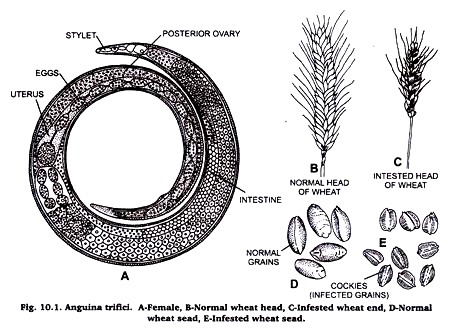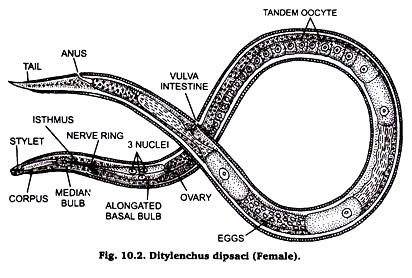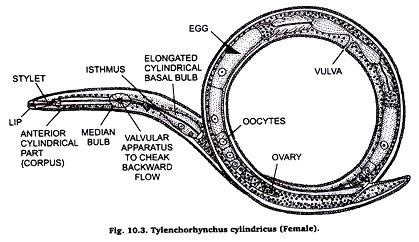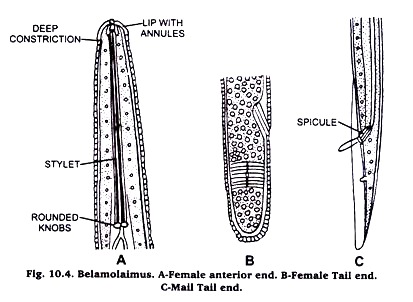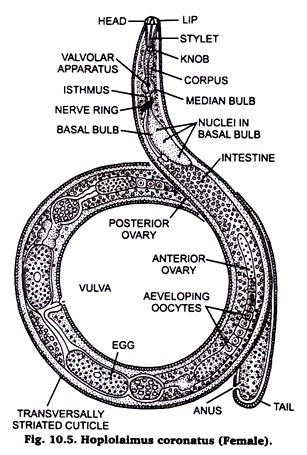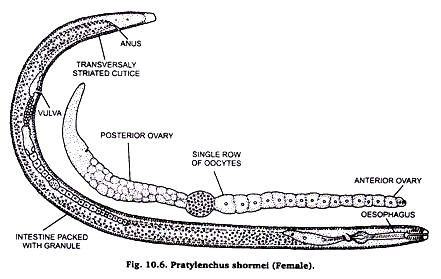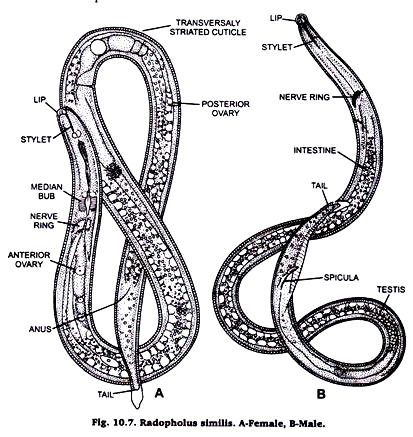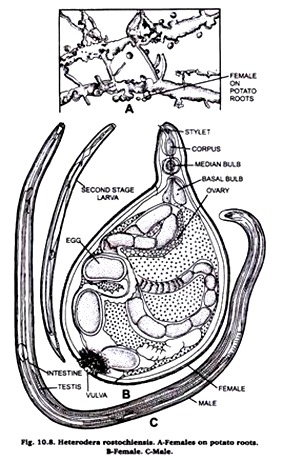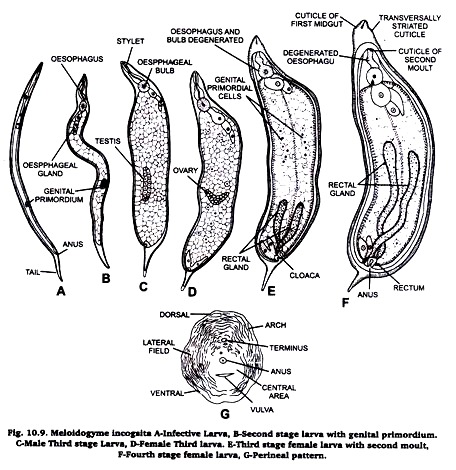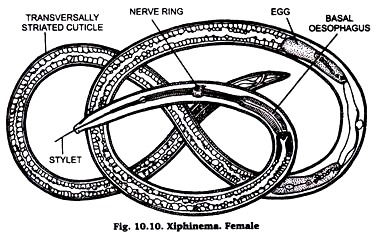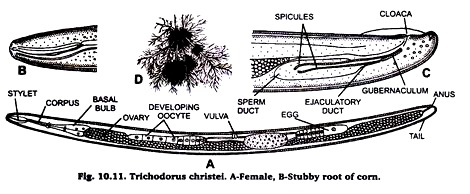The following points highlight the eleven main types of plant parasitic nematodes. The types are: 1. Anguniatritici 2. Ditylenchusdipsaci 3. Tylenchorhynchus 4. Belonolaimusgracilis 5. Hoplolaimuscaronatus 6. Pratylenchusthornei 7. Radopholussimilis 8. Heterodera rostochiensis 9. Meloidogyne Incognita 10. Xiphinemaamericanus 11. Trichodoruschristiei.
Type # 1. Anguniatritici:
Classification:
Phylum: Aschelminthes Cavity bearing animals
Class: Nematode Pseudo coelomate and un-segmented
ADVERTISEMENTS:
Order: Tylenchida Tylenchoid pharynx and stylet bearing nematodes.
Type: Angunina trificit
Habit and habitat:
Gall forming endophytonematodes found in seeds, stems and leaves of wheat plant and in cereals, grasses and other plants. Obligate parasites. Females immobile and males active.
ADVERTISEMENTS:
Distribution:
Specially found in wheat producing areas of the world such as USSR, India, Pakistan, Australia, China, New Zealand, Egypt and Brazil.
Comments:
1. Commonly called as Gall-nematode. It is first plant parasitic nematode to be discovered.
ADVERTISEMENTS:
2. Males measure 2.4 mm and females 3.8 mm in length. Body of males is straight while that of females is spiral.
3. Lateral fields indistinct. Deirids and plasmids absent.
4. Anterior end contains stylet or spear measuring 8-10 micron in length.
5. Oesophageal gland of female abnormal. There is a secondary storage gland between nerve ring and basal bulb of oesophagus.
6. Ovary has 2 flexors. Male contains spermatheca gubernaculum and spicules.
7. Life cycle (Biology). Seeds containing galls when sown burst releasing 800-33000 second stage (L2-stage) larvae. These penetrate roots and come into shoots. As seeds develop inflorescence, L2 stage larvae reach seeds and cause gall formation.
In galls, male and female mature and copulate. Females produce eggs which hatch into first stage larvae, these larvae after 24 hours moult and change into second stage. They remain in seeds and ready to infect new host plants in subsequent sowing.
Symptoms and pathogenecity:
ADVERTISEMENTS:
In the fields, Angeinatritici infected plants can be distinguished by wrinkled and twisted leaves, reduced and irregular inflorescence and as dying plant. Nematode causes characteristic cockle disease as shown in figure. Yield of wheat is reduced by A. tritici infection. Contamination of wheat beyond 5 percent affects colour, texture and taste of chapattis. Disease can be controlled by dry cleaning of seeds, hot water treatment and crop rotation.
Type # 2. Ditylenchusdipsaci:
Classification: Same as in a tritici.
Habit and habitat:
Very destructive, pathogenic, polyxenous parasitic nematode infecting Onion, Rye, Oat, Clover, Phlox, Alfalfa, Teasel Narciss, Wheat, Potato and Soil.
Distribution:
Cosmopolitan.
Comments:
1. Commonly called as Bulb and Stem nematode.
2. Both males and females measure 1.0-1.3 mm in length.
3. Body is covered by transversally striated cuticle. Lateral field is marked by incisors. Deirids usually visible near the base of neck.
4. Stylet with strongly developed knobs and less than 15 microns.
5. Basal oesophageal bulb with the usual 3 prominent and 2 indistinct nuclei.
6. Ovary single. Oocytes tandem. Testes outstretched.
7. Life cycle:
After copulation female deposits eggs which hatch first stage larva. After first, second and third moultings larva changes into second, third and fourth stage larvae which are infective larvae. Infective larvae infect new plants where they moult and change into fifth stage.
8. Symptoms and pathogenecity:
Teasel plants (Gokhroo) produce threads for textile industry. Threads are by burs (spiny seed cases). Above nematode infect burs which assume Puffy appearance and affect the yield of threads. Yield of alfalfa, rye, oat, onion is also affected.
Type # 3. Tylenchorhynchus:
Classification:
Same as in A. tritici.
Habit and habitat:
T. brassicea commonly infects, Cabbage, Cauliflower, Tomato, Radish, Sugar beet and lettuce. T. cylindricus is found associated with roots of desert plants. Nematode is found in outer layer of cortex lying parallel to longitudinal axis of the root.
Distribution: Cosmopolitan.
Comments:
1. Commonly called as stunt nematode.
2. Females measure 0.7-1.0 mm in length and males 0.67-1.0 mm.
3. Cuticle is coarsely started. Lateral fields with 4 incisors.
4. Stylet 22-28 microns with prominent cupped knobs.
5. Oesophagus contains anterior cylindrical part, median bulb slightly ovoid and basal bulb elongated and pyriform.
6. Ovaries and Testis outstretched, spicule tylenchoid and gubernaculum trough like.
7. Life cycle:
After copulation female produces number of eggs which hatch into first stage larvae. These larvae after moult change into second stage infective larvae which come in soil and are ready to infect a new host.
Symptoms and pathogenecity:
Younger seedlings are very susceptable to damage causing stimted growth. Yield of cabbage and cauliflower is very much reduced.
Type # 4. Belonolaimusgracilis:
Classification:
Same as in A. tritici.
Habit and habitat:
Highly pathogenic nematode found in the soil around roots of beans, sugar beet, strawberries celery, cabbage and cowpea.
Distribution:
Cosmopolitan.
Comments:
1. Commonly called as sting nematode.
2. Females measure 2.15 nm in length and males 1.7 mm. (Fig. 10.4).
3. Lip region is demarcated by rest of the body by a deep constriction having annules.
4. Stylet measures 157 micron in length with strong rounded knobs.
5. Oesophageal lumen convoluted in pro-carpus when spear is retracted.
6. Median oesophageal bulb spherical.
7. Oesophagus leads into intestine which extends into tail cavity.
8. Hemizonids adjacent to excretory pore, phasmids slightly interior. Ovaries with spermatheca.
Symptoms and pathogenicity:
Belnalaimus is very destructive nematode destroying the roots. If the main root is devoid of smaller roots, then the plant is infested by sting nematode.
Type # 5. Hoplolaimuscaronatus:
Classification:
Same as in A. tritici.
Habit and habitat:
Above nematode is found around roots of tomato, rice, brinjal, chilies, cowpea, cabbage, cauliflower, banana, mango, wheat, bajra, clover, alfalfa, sugarcane, grasses, grains, corn, cotton, apple and pine trees.
Distribution:
Cosmopolitan.
Comments:
1. Commonly called as crown-headed lance nematode.
2. Females and males measure 1.2-1.6 mm and 1.18-1.2 mm in length, respectively. Lip region of female is bluntly conoid and that of male spheroid Deirids and Hemizonids indistinct. (Fig. 10.5).
3. Stylets strongly developed with elongated, fureate and farward pointing knobs.
4. Ovaries are outstretched with developing oocytes.
5. Spermatheca is spheriod filled with granular sperms.
6. Male has bursa, Spicule straight, gubernaculum trough like and Telamon is curved.
7. Life cycle:
Consists of egg, first stage larva, second stage or infective larva. Second stage larva remains in soil to infect a new host plant.
Symptoms and pathogenecity:
These tiny nematodes cause stunting of growth of plants. They destroy epidermis, vascular bundles, xylem and phloem. They also cause plugging of xylem elements and hence stunted growth of plants. Their infestation reduces the yield of cereals and vegetables.
Type # 6. Pratylenchusthornei:
Classification:
Same as in A. tritici.
Habit and habitat:
This nematode is serious pathogenic parasite found in wheat, core, rice, bajra, maize, vegetables and fruits.
Distribution:
Cosmopolitan.
Comments:
1. Commonly called as Leison nematode.
2. Females and males are cylindrical measuring 0.45-0.77 and 0.5-0.57 mm in length, respectively.
3. Body cuticle has fine transverse striations. (Fig. 10.6).
4. Lip region contains 3 annules.
5. Anterior region is truncated. Basal plate of cephalic framework is characteristic of above species.
6. Stylet measuring 17-19 microns in length with strong knobs. Stylet is divided into 3 parts namely proorhabdion, mesorhabalion and telorbabdion.
7. Median bulb of oesophagus, nerve ring, excretory pose and oesophageal glands are clearly seen.
8. Gonads are monodelpline and outstretched.
9. Life-cycle involves egg → first stage larva, second stage larva (infective stage), third stage larva, fourth stage larva and fifth stage or adult stage.
Symptoms and pathogenicity:
Above nematodes cause stunted growth. It destroys cortex region of the maize plant causing formation of large cavities and hypertrophy.
Type # 7. Radopholussimilis:
Classification:
Same as in A. tritici.
Habit and habitat:
Above nematode is commonly found in soil around roots of banana, rice, weeds, grasses, tea, coffee, sweet potato, beans, squash, tomato and corn. It is also found in the rhizome of banana.
Distribution:
Cosmopolitan.
Comments:
1. Commonly called as burrowing nematode.
2. Females and males measure 0.5-0.7 mm is length. (Fig.).
3. Head slightly narrow and lip region is rounded marked by 3 striae.
4. Body is covered by transversally striated cuticle lateral field contains 3 incisors.
5. Spear or stylet is strong and well-developed.
6. Median bulb of oesophagus is spherical and its basal lobe much elongated containing 3 nuclei.
7. Anterior ovary extends up to median bulb and posterior ovary into the intestine.
8. Testis outstretched Gubernaculum and spicule present.
9. Life-cycle includes egg → first stage large → second stage infective larva, third stage larva, fourth stage larva and fifth or adult stage. Roots containing these larvae remain in soil waiting to insect a new crop.
Symptoms and pathogenecity:
The burrowing nematode causes severe damage to banana plants. It causes necrosis in roots and rhizomes which is manifested by retarded growth, leaf yellowing and falling of mature plant. Hot water treatment of roots and rhizomes kills nematodes.
Type # 8. Heterodera rostochiensis:
Classification:
Same as in A. tritici.
Habit and habitat:
Above nematode in found in all potato (solenum tuberosum) and tomato (lycopersican esculentum) growing regions. Females on maturity four cysts on roots of potato plant and are known as cyst farming nematode. H. sachachtii is found in sugar bea and H. avenae in germinating plants.
Distribution:
Cosmopolitan.
Comments:
1. Commonly called Golden nematode of potato or cyst farming nematode.
2. Female with sac like body and a neck measures 0.5-0.8 mm in length. Female contains large amount of eggs.
3. Body cuticle is marked with punctuations giving striated appearance.
4. Spear with rounded knobs is distinct. Vulva posterior.
5. Males cylindrically elongated measuring 1.0-1.1 mm is length. Lip region is marked by 6-8 annules.
6. Testis single, spicule pointed and hemizonids adjacent to excretory pore.
7. Life-cycle consists of egg, first stage large, second stage (infective larva), third stage larva, fourth stage larva and fifth or adult stage. Cyst contains second stage larvae and when next crop is sown they infect roots, cause giant cell formation in which they accumulate. Larvae after moulting change into adult male and female. Female attaches to roots and transforms itself into cyst.
Symptoms and pathogenecity:
Infected potato plant reveals curling and wilting of leaves, stunted growth and finally plant dies. Yield of potato is reduced due to above nematode. Infestation can be controlled by nematicide treatment fumigation and crop rotation.
Type # 9. Meloidogyne Incognita:
Classification:
Same as in A. tritici.
Habit and habitat:
It is found in galls formed on roots of tomato, brinjal okra, chilies and potato plants. Roots appear as if having several knots or nodules.
Distribution:
Cosmopolitan.
Comments:
1. Commonly called as Root knot nematode.
2. Females measure 0.45-0.76 mm in length and males 0.87-1.17 mm.
3. Body of female oval with a distinct neck. Cephalic framework highly sclerotisted. Oesophagustylenchoid.
4. Spear or stylet measures 10-14 micron and contains rounded knobs.
5. Vulva and anus terminal.
6. Cuticular striations around vulva form characteristic perineal pattern. Dorsal arch high, irregular and marked by several zigzag and broken stare.Vulvular width 21.-23 mm.
7. Male is vermiform with single testis, curved spicule and thickened gubernaculum.
8. Live cycle includes egg, first stage larva, infective second stage larva, male and female third and fourth stage larva and adults. Second stage larva penetrates epidermis of roots causing giant-cell formation.
Symptoms and pathogenecity:
Root-knot infested plants show stunted growth, curled and wilted leaves and several galls in roots. Yield of tomato is considerably reduced. Control of above nematode could be achieved by cross rotation and soil fumigation.
Type # 10. Xiphinemaamericanus:
Classification:
Phylum: Aschelminthes Cavity bearing ferns
Class: Nematoda Pseudocodomate, un-segmented round worms
Order: Dorylcimida Dorylaimin pharynx
Type: Xiphinemaamericanus
Habit and habitat:
Above nematode is a pathogenic ectophytonematode found in soil around roots of several plants such as corn, grass, citrus, oak, pine, wheat and strawberry.
Distribution:
Cosmopolitan but specially found in U.S.A., Israel, Sri Lanka and India.
Comments:
1. Commonly called as Dagger nematode.
2. Females and Males measure 1.5-2.0 mm and 1.6-2.0 mm respectively.
3. Lip region contains 2 circlets of 6 and 10 papillae lateral cords about one-fourth of body width.
4. Stylet in 120-140 micron in length. Pores arranged in 2 rows. Oesophagus consists of long slender anterior regions and basal bulb. Oesophagus leads into intestine which has course refractive granules in its cells.
5. Ovaries reflexed and testis 2 in number.
6. Life-cycle involves egg, first stage larva, second stage larva, third stage larva, fourth stage larva and adult male and female.
Symptoms and pathogenecity:
Dagger destroys, epiblema of infested plants and opens way for various viral and bacterial infections. Xiphinema index acts as a vector for fan leaf virus of grapevine.
Type # 11. Trichodoruschristiei:
Classification:
Same as in Xiphinema.
Habit and habitat:
This nematode is found in soil around roots of oat, corn, cabbage, grass, beat, onion, bean, rye, tobacco and pea.
Distribution:
Cosmopolitan.
Comments:
1. Commonly called as stubby-root nematode.
2. Females measure 0.46-0.7 mm and males 0.58-0.6 mm.
3. Body more or less cylindrical. Excretory pore near the base of oesophagus.
4. Oesophagus slightly overlaps the anterior end of intestine. Oesophageal papillae absent.
5. Spicule is straight measuring 63 micron. Gubernaculum present.
6. Life-cycle consists of egg, first stage, second stage, third stage, fourth stages larvae and adults.
Symptoms and pathogenecity:
Stubby root nematode is notorious causing stunted growth of the host plant. It feeds on root-tips causing necrosis, loss of meristematic tissues and shortening of mitotic regions and thickening of protoxylem. Infestation could be controlled by fumigation of soil and crop rotation.
